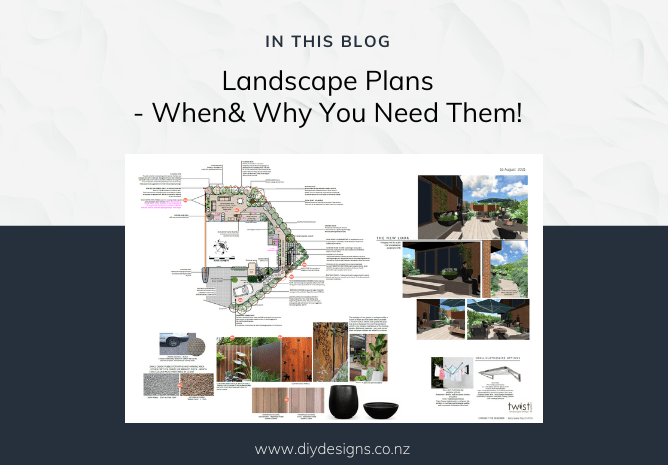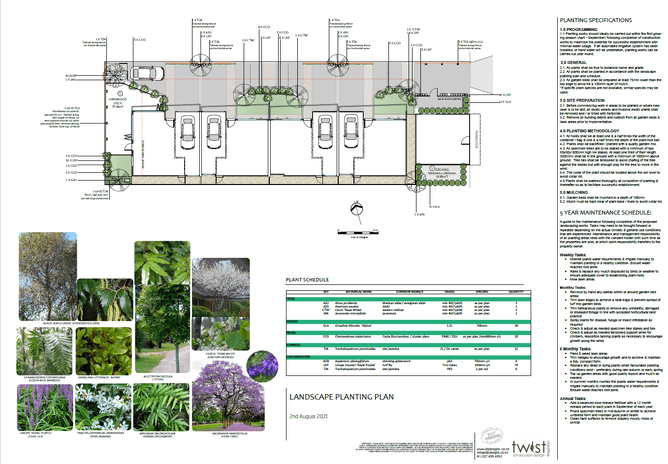What is a landscape plan?
A landscape plan is a record of, or a proposal for a landscape, shown from an overhead or ‘birds-eye’ perspective.
You can be asked by Council to supply a landscape plan at the outset of a property development such as a subdivision, or for significant home renovation or landscaping projects that require consent. Rather than see this as a nuisance, think of it as an opportunity, as it means that the design of your landscape is being considered from the outset as an integral part of your project, rather than as an afterthought once building work is completed. A landscape plan for resource consent purposes also provides documentation that local planning objectives and zoning regulations are observed.
However, Landscape Plan is a bit of a blanket term, covering a range of more specific landscape plan types - all of which serve very specific purposes and very different purposes. So, what are the most commonly used types of landscape plans, and why do you need them?
1. SITE PLAN
A site plan is a 2Dplan drawing that shows the garden or property in its existing form, site plans are also known as survey plans. They are all created differently, with varying levels of detail, depending on what the plan is intended to be used for and who has created it, but typically they record things such as site coordinates, cadastral (legal) property boundaries / the site parcel, contours and site levels, and underground services such storm water and wastewater pipes. Landscape site plans also show the location of any structures already on the property, such as houses, outbuildings and sheds; as well as existing infrastructure such as decks, driveways, fences and retaining walls. Significant garden areas and key plants such as hedgerows and trees are also shown.
Structural landscaping projects such as swimming pools require a site or survey plan that has been prepared by a qualified surveyor, however for the majority of garden design projects, either you or your garden designer can take the measurements and draw a scaled site plan yourself.
When and Why Do You Need a Site Plan:
There are two main reasons when and why you need a site plan during your landscaping project.
- To show the difference between what already exists and what you are planning to add or remove.
- To provide accurate dimensions for planning garden changes, ie the development of a garden or landscape design.
2. BASE PLAN
If you have employed a professional garden designer or landscape architect, you might never even see this plan, as it is typically used by the designer as part of the design process.
A base plan is essentially a stripped-back version of the site plan where any items that will not be a part of the new design, such as old paths, decks or structures and badly placed trees or garden areas, are no longer shown. This creates a ‘clean’ site plan, upon which new features can be accurately plot around the bones of the original garden.
3. SCHEMATIC LANDSCAPE PLAN
A schematic plan could be considered an overview plan. Prepared in 2D from a birds-eye perspective it shows the proposed location, shapes and purposes of the various spaces within a garden, with a minimal amount of detail or description.
When and Why You Need One:
- Schematic plans are particularly useful at the beginning of the landscape design process in large scale landscaping projects such as lifestyle blocks, or as a planning tool for smaller garden projects.
- They provide a broad sweep picture of the site from the outset and can be layered upon to create a more detailed plan for each space as your project develops.
- While you don’t technically need one, getting a schematic plan drawn up at the start of your project is a good way to make sure all your key needs have been met by the design, before delving into the finer details of each space.
- Landscape designers often create a schematic plan as part of their design process although you might not see it in its raw form, as it will form the basis or underlay of a concept plan.
4. LANDSCAPE CONCEPT PLAN
A landscape concept plan is one of the most common types of landscape plans, it is also known as a garden concept plan. It is called a concept plan because it's still in the planning & ideas stage. The level of detail varies from designer to designer however, at a minimum, it is a simple 2D (birds-eye perspective) layout showing the proposed layout of both the hardscaping and the soft-scaping areas of the proposed garden in its finished form. It will generally include the most important planting such as trees and shrubs, although these may be generically named such as ‘tree 4m+’, rather than specified species. A concept plan will also often include things such as photos, sketches and descriptive notes.
When and Why Do You Need One:
- A good landscape concept plan brings to life a vision and pins down elusive ideas, so you can understand, explore and refine a design before you commit to building it.
- If you ask a landscape contractor for a landscaping quote, the first question they will usually ask you is “ do you have a plan?”. This is because a plan provides a scaled, descriptive document from which landscaping estimators can provide accurate and informed pricing.
- In many instances, a landscape concept plan can provide enough information to build a garden if you are doing it yourself, or hiring professional contractors on a charge up or hourly rate basis.
If you are seeking a competitive quote or a fixed price estimate (quote) from your landscaper, and your concept plan doesn't provide adequate detail, the contractor may ask you for a detailed landscape plan.
DETAILED LANDSCAPE PLAN
A detailed landscape plan is also known as a developed landscape plan. It’s a firmed-up version of a landscape concept plan and contains specifications and details for landscaping materials, finishing details and the overall spatial layout. The details are locked down using a mix of construction or detail drawings, and descriptive notes.
When And Why Do You Need One:
- One of the biggest benefits of having a detailed landscape plan is that the garden gets built exactly as your designer intended it, as the details are very clearly laid out from the outset.
- A detailed plan will provide clarity around the finer finishing aspects which is invaluable if your project is complex, or if you are planning on getting comparative quotes from multiple contractors as you can be sure they are all pricing on the same scope of works and quality of finish.
Detailed landscape plans usually provide limited detail on planting, as this is covered in a separate planting plan.
PLANTING PLAN
A planting plan is a detailed construction drawing drawn in a birds-eye view, which focuses on detailed information relating specifically to the planting aspect of a garden layout. It shows the location and quantity of the vegetation in the garden or landscape and provides plant-specific information such as what the plants are, how far apart they are spaced etc. A planting plan also includes a plant schedule or plant list, so you know how many plants to buy and often it will include information on planting and garden maintenance.
When And Why Do You Need One:
Planting is one of the trickiest aspects of a garden project and choosing which plants to use can be overwhelming during a DIY landscape project. A professionally prepared planting plan takes away the angst of plant selection and provides you with a well thought out planting scheme, a detailed guide to planting and purchasing the correct plans, and gives you a record of what your plants are called.
A planting plan is used as part of the landscape estimating process, to quantify soil and mulch needs, as well as providing accurate information for the pricing and procurement of plants. It is also used onsite during the planting phase of a landscape project to ensure that the plants are placed in the correct places. Planting plans are often requested as part of the resource consent process
Auckland landscape design company DIY Designs is located in Titirangi, West Auckland and work online providing a range of affordable fixed-price landscape and planting plans to help get your garden transformation underway.


